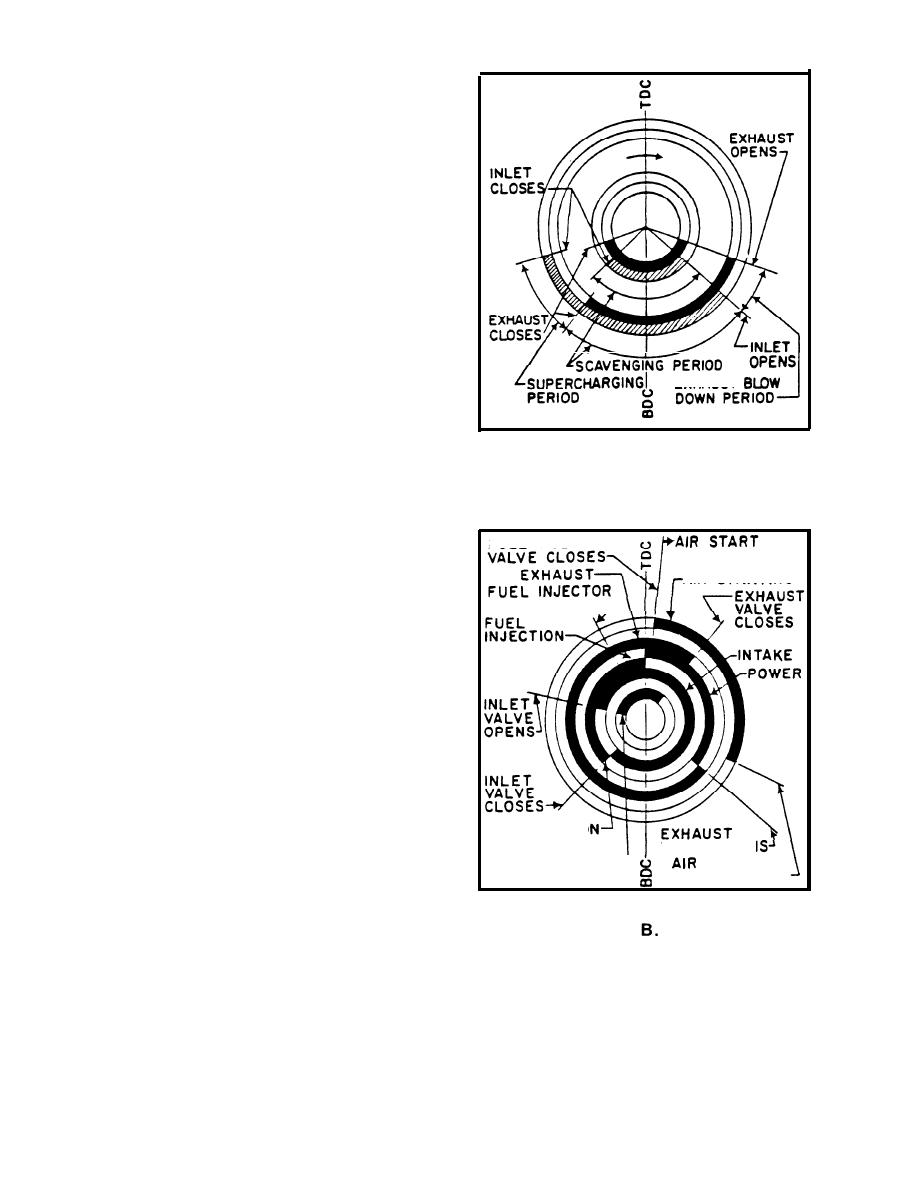

Custom Search
|
|

|
||
 TM 5-685/NAVFAC MO-912
air at 3 pounds per square inch (psi) to 6 psi) to
sweep the cylinder, further purging the exhaust gas
and providing a fresh clean charge for the next
cycle. The piston reaches and passes through BDC.
The compression stroke then begins again.
b. Four-cycle. The series of events taking place in
a four-cycle engine are: inlet stroke, compression
stroke, expansion or power stroke, and exhaust
stroke. Four strokes (two revolutions of the crank-
shaft) are necessary to complete the cycle.
(1) Inlet stroke. As the piston starts downward
from TDC, the inlet (intake) valve opens and allows
the piston to suck a charge of fresh air into the
cylinder. This air may be supplied at a pressure
higher than atmospheric air by a supercharger.
(2) Compression stroke. As the piston nears
BDC, the air inlet valve closes, sealing the cylinder.
EXHAUST
Energy supplied by the crankshaft from a flywheel,
or power from other cylinders, forces the piston up-
ward toward TDC, rapidly compressing the air and
increasing the temperature and pressure within the
A.
cylinder.
(3) Power stroke. As the piston approaches
TDC, an amount of fuel (modulated by the governor)
is injected (sprayed and atomized) into the cylinder
F U E L INJECTOR
which is ignited by the high temperature, and com-
VALVE OPENS
bustion starts. Combustion, at a controlled rate,
A I R STARTING
further increases the temperature and pressure to
accelerate the piston toward BDC. The expansion of
VALVE OPENS7
the hot gases forces the piston down and turns the
crank against the load. Engine efficiency depends
on the fuel charge being completely burned during
the power stroke.
(4) Exhaust stroke. As the piston passes
through BDC at the end of the power stroke, the
exhaust valve opens. The piston, using stored en-
ergy from the flywheel or from the power stroke of
another cylinder, forces the burned gases from the
cylinder through the exhaust port. As the piston
approaches TDC, the exhaust valve is closed and
the air intake valve opens to begin another cycle.
COMPRESS10
c. Engine timing. Engine timing is critical. Intake
VALVE OPEN
START
OVERLAP-
and exhaust valves have to open a n d close to allow
VALVE CLOSES
the greatest amount of work to be extracted from
combustion. They must also be open long enough to
allow fresh air to flow into and exhaust gas to flow
out of the cylinder. Fuel must be injected at proper
rates during certain periods of time to get smooth
Figure 3-5. Timing diagrams
pressure rise and complete combustion. Timing for
A) FOR A TWO STROKE CYCLE,
two-stroke cycle and four-stroke cycle engines dif-
B) FOR A FOUR STROKE CYCLE.
fers (refer to the timing diagrams in fig 3-5). Dia-
gram A illustrates two forms of the two-stroke cycle
The outer portion covers a port control (uniflow)
engine. The inner portion covers the typical crank-
system. Diagram B illustrates timing for a four-
case scavenging type with uncontrolled fixed ports.
stroke cycle engine.
3-5
|
 
|
|
 |
||